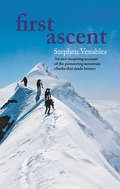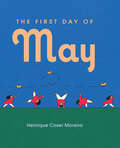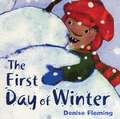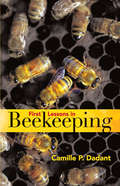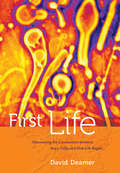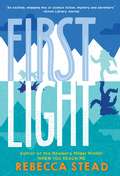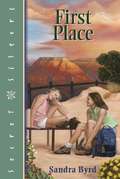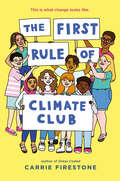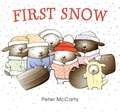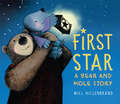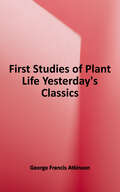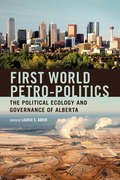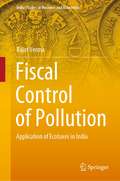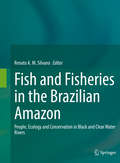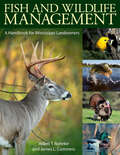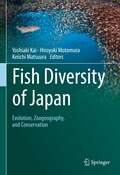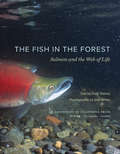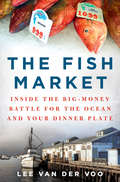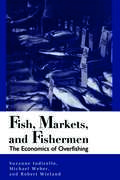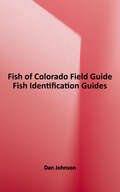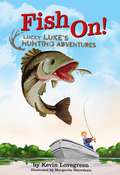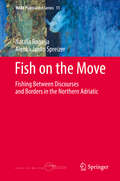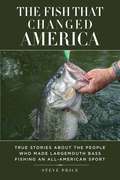- Table View
- List View
First Ascent
by Stephen Venables"What transformed pure physical delight into something deeper was the fact that no-one had been here before..."Discover the fascinating stories of the men and women who have scaled the world's highest peaks. Featuring accounts of some of the world's most treacherous mountain climbs, this amazing collection covers the ascent of Mont Blanc in the 1780s, the golden age of alpine climbing which saw the Matterhorn and the Bietschhorn conquered, as well as the climbing of the great summits of the Americas and the Himalayan peaks, Everest and Annapurna.First Ascent is a unique survey of human achievement and a tribute to the adventurous spirit of mountaineers past and present.
The First Day of May
by Henrique Coser MoreiraHere is a book to celebrate firsts. That first magical day of spring, when it seems the whole world is bursting with life. That first time bursting out of your house after being cooped up for SO long. Your first time on the swingset. Your first time seeing a butterfly. Your first time exploring the world with someone you love. From Henrique Coser Moreira comes a wordless ode to joy and discovery that will stir readers young and old. P R A I S E ★ "Pure joy." –BookPage (starred) ★ "All the delights of spring are found within the covers in this charming, wordless picture book." –School Library Journal (starred) ★ "Ivan Brunetti by way of Rowboat Watkins, and readers will sense the opportunities waiting just outside their own doors. A joyous adventure, bright and brimming with exuberance." –Booklist (starred) ★ "This wordless book celebrates—with abundant style—the arrival of spring… playful and exceptionally funny… A breath of fresh air, in more ways than one." –Horn Book (starred) "A quirky and buoyant romp through spring." –Kirkus "Wordless panels mix the whimsical and the mundane in depicting a child’s exuberant outdoor exploits on the titular first of May." –Publishers Weekly
The First Day of Winter
by Denise FlemingA snowman comes alive as the child building it adds pieces during the first ten days of winter.
First Lessons in Beekeeping
by Camille Pierre DadantIn light of the dwindling honey bee population, this century-old guide is more relevant than ever. Written by the scion of a celebrated family of beekeepers that continues to operate today, the richly illustrated volume is the perfect companion for beginning beekeepers as well as those with a casual interest in bees. Reader-friendly information ranges from background on bee anatomy and the social structure of bee communities to different types of hives and how they function, honey production, wintertime beekeeping, and other practical matters. Author Camille Pierre Dadant was the son of Charles Dadant, one of the fathers of modern beekeeping techniques, inventor of the Dadant beehive, and founder of one of the first beekeeping equipment manufacturers. The business is still extant and run by the family, as is their publication, American Bee Journal. The old-fashioned charm of Dadant's narrative rests upon a solid foundation of timeless scientific knowledge, complemented by many informative drawings and photographs.
First Life: Discovering the Connections Between Stars, Cells, and How Life Began
by David DeamerThis pathbreaking book explores how life can begin, taking us from cosmic clouds of stardust, to volcanoes on Earth, to the modern chemistry laboratory. Seeking to understand life's connection to the stars, David Deamer introduces astrobiology, a new scientific discipline that studies the origin and evolution of life on Earth and relates it to the birth and death of stars, planet formation, interfaces between minerals, water, and atmosphere, and the physics and chemistry of carbon compounds. Deamer argues that life began as systems of molecules that assembled into membrane-bound packages. These in turn provided an essential compartment in which more complex molecules assumed new functions required for the origin of life and the beginning of evolution. Deamer takes us from the vivid and unpromising chaos of the Earth four billion years ago up to the present and his own laboratory, where he contemplates the prospects for generating synthetic life. Engaging and accessible, First Life describes the scientific story of astrobiology while presenting a fascinating hypothesis to explain the origin of life.
First Light
by Rebecca SteadPeter is thrilled to join his parents on an expedition to Greenland, where his father studies global warming. Peter will get to skip school, drive a dogsled, and-finally-share in his dad's adventures. But on the ice cap, Peter struggles to understand a series of visions that both frighten and entice him. Thea has never seen the sun. Her extraordinary people, suspected of witchcraft and nearly driven to extinction, have retreated to a secret world they've built deep inside the arctic ice. As Thea dreams of a path to Earth's surface, Peter's search for answers brings him ever closer to her hidden home. Rebecca Stead's fascinating debut novel is a dazzling tale of mystery, science and adventure at the top of the world.From the Hardcover edition.
First Place (Secret Sisters Book #9)
by Sandra ByrdWill the Rim-to-Rim hike make Tess a hero -- or a big-time loser? The Secret Sisters are minding their own business at a Little League game when the snooty Coronado Club stirs up trouble -- again! Tess and her friends have earned the best cabin at Outdoor School -- the one that Lauren and her gang wanted -- and now they're out for revenge. Erin blurts out that Tess is racing across the Grand Canyon Rim-to-Rim with her dad and certainly will win first place. Lauren insists Tess won't make it. Even worse, Lauren makes sure the whole sixth grade will hear all about the race at the Outdoor School's opening-night campfire! Tess is left worrying in silence, not wanting to share the secret that she knows could lead to disaster and embarrassment.
The First Rule of Climate Club
by Carrie FirestoneAn eighth grader starts a podcast on climate activism and rallies her friends to create lasting change in their local community and beyond, in this companion to Dress Coded.When Mary Kate Murphy joins a special science pilot program focused on climate change, the class opens her eyes to lots of things she never noticed before about her small suburban town: Kids waste tons of food at school without a second thought. Parents leave their cars running in the pick-up lane all the time. People buy lots of clothes they don&’t really need. Some of her friends who live in the city and are bused to her school don&’t always feel included. And the mayor isn&’t willing to listen to new ideas for fixing it all. Mary Kate and her friends have big plans to bring lasting change to their community and beyond. And now is the time for the young people to lead and the leaders to follow—or get out of the way.
First Snow
by Peter McCartyFirst Snow is the newest picture book from acclaimed Caldecott Honor–winning author-illustrator Peter McCarty, which extends the winning world of animal characters established in Chloe, a Kids' Indie Next List Pick and Kirkus Reviews Best Children's Book, and Henry in Love, a New York Times Best Illustrated Book.
First Snow
by Bomi ParkLook out. Now look up. From the sky one flake falls, then another. And just like that--it's snowing. In this beautiful book from debut creator Bomi Park, a young girl wakes up to the year's first snowy day. From her initial glimpse out the window to her poignant adventures--rolling a snowman, making snow angels--the girl's quiet quests are ones all young readers will recognize. Simple, muted text and exquisite, evocative art conjure the excitement of a day spent exploring the wonder of snow--and the magic that, sometimes literally, such a day brings. As subtly joyful as a snow day itself, this book will find its home in the hearts of young adventurers everywhere.
First Star: A Bear and Mole Story (Bear and Mole #5)
by Will HillenbrandBest friends Bear and Mole can't wait to go camping and sleep under the stars--but Mole worries, what if they get lost in the dark?Rolling up sleeping bags, picking fresh berries, and climb-climb-climbing, the two buddies are having a great time hiking to Camp Tiptop. They especially can't wait to watch the sunset. But Mole soon realizes that when the sun goes down. . .it will be dark. What if they get lost?Seeing Mole nervous, Bear decides to tell his friend the legend of a special star--the First Star--that will always help them find their way. Featuring the popular characters and cozy illustrations of Will Hillenbrand's earlier Bear and Mole books, First Star is a perfect bedtime book, an ode to friendship, and a gentle reminder that no matter how dark it gets, your loved ones will always help you find your way.
First Studies of Plant Life (Yesterday's Classics)
by George Francis AtkinsonA guide to discovery of the forces at work in the world of plants. Through germinating seeds and varying their growing conditions, students learn by observation the different ways seeds germinate and young plants respond to moisture and light. Further experiments shed light on the manner of nourishment, respiration, and reproduction. The reader is given plenty to ponder since the text often poses questions without supplying answers. The life stories of the sweet pea, oak, ferns, moss, and mushrooms and an account of some of the forces plants have to contend with in their struggle to survive encourage students to continue to read and interpret their surroundings. An engaging introduction to botany for middle school and beyond.
First World Petro-Politics: The Political Ecology and Governance of Alberta
by Laurie AdkinFirst World Petro-Politics examines the vital yet understudied case of a first world petro-state facing related social, ecological, and economic crises in the context of recent critical work on fossil capitalism.A wide-ranging and richly documented study of Alberta's political ecology - the relationship between the province's political and economic institutions and its natural environment - the volume tackles questions about the nature of the political regime, how it has governed, and where its primary fractures have emerged. Its authors examine Alberta's neo-liberal environmental regulation, institutional adaptation to petro-state imperatives, social movement organizing, Indigenous responses to extractive development, media framing of issues, and corporate strategies to secure social license to operate. Importantly, they also discuss policy alternatives for political democratization and for a transition to a low-carbon economy.The volume's conclusions offer a critical examination of petro-state theory, arguing for a comparative and contextual approach to understanding the relationships between dependence on carbon extraction and the nature of political regimes.
Fiscal Control of Pollution: Application of Ecotaxes in India (India Studies in Business and Economics)
by Rajat VermaThis volume analyses the process and structure of ecotaxes in India to bring forth its rationale, application and incidence on emerging environmental problems on the backdrop of the environmental issues confronted by the Indian economy. Being at infant stage in India, the concept of ecotaxes is plagued with large empirical difficulties. This book provides a holistic understanding of the complexities in the design and implementation of these fiscal instruments at the country level. After elaborating on the theory, history of its applications, the book provides an innovative methodological exercise. It examines the adequacy and relevance of ecotaxation in the Indian context, along with ensuring that the distortions due to the proposed levy are minimised. The incidence of these taxes on the households, the double dividend hypothesis and the effect on competitiveness of the producer are a few of the core themes elaborated upon in this book. This is demonstrated through a linear general equilibrium framework of Environmentally extended Social Accounting Matrix (E-SAM).The book provides material for the researchers and graduate students on the methodological structure of eco-taxes. The proposed methodological intervention could be utilised by the researchers who wish to analyse the macroeconomic impact of any tax through the framework of Social Accounting Matrix (SAM). Additionally, the process as well as the implications and nuances provided in the book will assist the policy makers to design innovative policies for dealing with environmental issues. The volume also has something for the practitioners by helping them comprehend various effects of these instruments on different stake holders of the economy and thus will be useful as a policy prescription. The three policy scenarios analysed in this study could be considered by the policymakers while attempting to design these instruments in the Indian context and thus ending the extensive reliance on the age old and grossly ineffective Command and Control (CAC) Policies.
Fish: A Picture Book
by Liam Francis WalshA boy and his dog embark on a fishing journey.Their first catch of the day: a big fat letter F.Their second? A slippery I. After an epic journey beneath the lake's surface, they find what they came for-- a FISH, along with some unanticipated menace from a few other letters.This clever, wordless picture book, by a popular New Yorker cartoonist, is filled with charm and heart and will have no problem swimming its way into the hearts of young readers.
Fish and Fisheries in the Brazilian Amazon: People, Ecology and Conservation in Black and Clear Water Rivers
by Renato A. M. SilvanoThis book provides comparative data on fish ecology and small-scale fisheries between Tapajos (clear water) and Negro (black water) rivers, in the Brazilian Amazon. These rivers are less studied than white water rivers and few books on Amazon fishes have addressed more than one river basin. These data can serve as a baseline to check future changes or impacts in these rivers, which can be affected by development projects, such as highways, deforestation, mining and dams. Besides information on fish biology, the book also discusses fish uses, fisheries and its importance for riverine people, comparing these data for each fish species between sites located inside and outside conservation units. The book is an outcome of the research project ‘Linking sustainability of small-scale fisheries, fishers’ knowledge, conservation and co-management of biodiversity in large rivers of the Brazilian Amazon’, which was coordinated by the editor of this volume and funded by United States Agency for International Development (USAID) and National Academies of Science, Engineering and Medicine (NAS).
Fish and Wildlife Management: A Handbook for Mississippi Landowners
by Adam T. Rohnke and James L. CumminsFeaturing over five hundred illustrations and forty tables, this book is a collection of in-depth discussions by a tremendous range of experts on topics related to wildlife and fisheries management in Mississippi. Beginning with foundational chapters on natural resource history and conservation planning, the authors discuss the delicate balance between profit and land stewardship. A series of chapters about the various habitat types and the associated fish and wildlife populations that dominate them follow. Several chapters expand on the natural history and specific management techniques of popular species of wildlife, including white-tailed deer, eastern wild turkey, and other species. Experts discuss such special management topics as supplemental, wildlife-food planting, farm pond management, backyard habitat, nuisance animal control, and invasive plant species control. Leading professionals who work every day in Mississippi with landowners on wildlife and fisheries management created this indispensable book. The up-to-date and applicable management techniques discussed here can be employed by private landowners throughout the state. For those who do not own rural lands but have an interest in wildlife and natural resources, this book also has much to offer. Residents of urban communities interested in creating a wildlife-friendly yard will delight in the backyard habitat chapter specifically written for them. Whether responsible for one-fourth of an acre or two thousand, landowners will find this handbook to be an incalculable aid on their journey to good stewardship of their Mississippi lands.
Fish Diversity of Japan: Evolution, Zoogeography, and Conservation
by Yoshiaki Kai Hiroyuki Motomura Keiichi MatsuuraThis book reviews and summarizes the studies on the fish diversity of Japan. It covers the present knowledge of ichthyofauna, habitat distribution, phylogeography, ecology, morphology, and conservation, as well as the history of ichthyology and fish collections in Japan. The book comprises five parts: I. Fish Diversity and Ichthyology of Japan, II. Habitat Distribution and Species Diversity, III. Diversity within Species: Phylogeographic Perspective on Japanese Fishes, IV. Morphological and Ecological Diversifications, and V. Conservation of Fish Diversity in Japan. The Japanese Archipelago is surrounded by two major warm and one cold currents. It is located in the western North Pacific and encompasses several climatic regimes from north to south. Although the land area of Japan is small, the Exclusive Economic Zone (EEZ) of Japan ranks as the sixth largest in the world, including several marginal seas (Sea of Okhotsk, Sea of Japan, and East China Sea), and deep trenches (Izu-Ogasawara, Japan, and Kurile Trenches). Owing to a variety of marine habitats and a complex geological history, Japan has a rich fish species diversity, representing over 4,500 species in 370 families. The richness of fish species diversity has attracted many scientists since the late 1700s, and continuous studies have led to the development of ichthyology in Japan. With chapters written by leading experts in the field, the book will provide a stimulating and reliable resource for future research and contribute to the progress of ichthyology of the world.
The Fish in the Forest
by Dale StokesThe Fish in the Forest is an elegantly written, beautifully illustrated exploration of the complex web of relationships between the salmon of the Pacific Northwest and the surrounding ecosystem. Dale Stokes shows how nearly all aspects of this fragile ecosystem--from streambeds to treetops, from sea urchins to orcas to bears, from rain forests to kelp forests--are intimately linked with the biology of the Pacific salmon. Illustrated with 70 stunning color photographs by Doc White, The Fish in the Forest demonstrates how the cycling of nutrients between the ocean and the land, mediated by the life and death of the salmon, is not only key to understanding the landscape of the north Pacific coast, but is also a powerful metaphor for all of life on earth.
The Fish Market: Inside the Big-Money Battle for the Ocean and Your Dinner Plate
by Lee van der VooGulf Wild -- the first seafood brand in America to trace each fish from the sea to the table -- emerged after grouper, the star of fried fish sandwiches, fell off menus due to overfishing. The brand was born when the government privatized the rights to fish to fix the problem. Through traceability, Gulf Wild has met burgeoning consumer demand for domestic, sustainable seafood, selling in boutique grocers and catapulting grouper from the hamburger bun to the white tablecloth. But the property rights that saved grouper also shifted control of the fish from public to private, forever changing the relationship between wild seafood and the people that eat it. Aboard fishing vessels from Alaska to Maine, inside restaurants of top chefs, and from the halls of Congress, in The Fish Market, journalist Lee van der Voo tells the story of the people and places left behind in this era of ocean privatization--a trend that now controls more than half of American seafood. Following seafood money from U.S. docks to Wall Street, she explains the methods that investors, equity firms, and seafood landlords have used to capture the upside of the sustainable seafood movement, and why many people believe in them. She also goes behind the scenes of the Slow Fish movement--among holdouts against privatization of the sea-- to show why they argue consumers don't have to buy sustainability from Wall Street, or choose between the environment and their fisherman.
Fish, Markets, and Fishermen: The Economics Of Overfishing
by Michael L. Weber Suzanne Iudicello Robert WielandA significant number of the world's ocean fisheries are depleted, and some have collapsed, from overfishing. Although many of the same fishermen who are causing these declines stand to suffer the most from them, they continue to overfish. Why is this happening? What can be done to solve the problem.The authors of Fish, Markets, and Fishermen argue that the reasons are primarily economic, and that overfishing is an inevitable consequence of the current sets of incentives facing ocean fishermen. This volume illuminates these incentives as they operate both in the aggregate and at the level of day-to-day decision-making by vessel skippers. The authors provide a primer on fish population biology and the economics of fisheries under various access regimes, and use that information in analyzing policies for managing fisheries. The book: provides a concise statistical overview of the world's fisheries documents the decline of fisheries worldwide gives the reader a clear understanding of the economics and population biology of fish examines the management issues associated with regulating fisheries offers case studies of fisheries under different management regimes examines and compares the consequences of various regimes and considers the implications for policy makingThe decline of the world's ocean fisheries is of enormous worldwide significance, from both economic and environmental perspectives. This book clearly explains for the nonspecialist the complicated problem of overfishing. It represents a basic resource for fishery managers and others-fishers, policymakers, conservationists, the fish consuming public, students, and researchers-concerned with the dynamics of fisheries and their sustenance.
Fish of Colorado Field Guide
by Dan JohnsonGo Fishing with Colorado's Famous Identification Guide! Fishing is a perfect outdoor activity for all ages and skill levels, and the Centennial State is an angler's paradise. Reel in fish, and make identifying your catches a snap. The Fish of Colorado Field Guide by Dan Johnson features detailed information about 85 species of Colorado fish. When you're not sure what you caught, grab the handy guide and narrow your choices by family. Then identify your prize with the intricately detailed fish illustrations. Further, verify the type of fish using the "Similar Species" comparisons. Book Features: - Detailed information about 85 species - Professional-quality illustrations--perfect for fish identification - Fascinating facts on spawning behavior, feeding habits, and more - Fishing tips and inside information for easily locating fishing hotspots - Bonus resources such as state fishing records and answers to frequently asked questions Grab the Fish of Colorado Field Guide for your next angling adventure. It's essential for every tackle box, beach bag, RV, and cabin. Plus, its convenient size makes it perfect for the dock or boat.
Fish On! (Lucky Luke's Hunting Adventures)
by Kevin LovegreenA perfect day on a magical lake filled with fish. The smell of pine trees, the bright sunshine, a nice breeze: the stage is set for a great adventure! Join Luke at his grandparents' lake cabin, tucked way back in the woods, as he experiences an amazing morning of fishing. Luke has to find the hot spots, pick the right lures, and chase a lunker that steals his lucky Basserino. It's the kind of morning anyone who's ever held a rod dreams of!
Fish on the Move
by Nataša Rogelja Alenka Janko SpreizerThis book analyses the relation between different discourses and actors through an ethnographic approach, showing not only how fishermen in Slovenia respond to international political economy, how they struggle to survive but also how they generate small changes. Fishing in the northeastern part of the Adriatic Sea makes for a substantial economy anchored in many stories. Regional conflicts, wars, the demise of empires and the rise of nation states with ensuing maritime border issues, socialist heritage, transnational and transformational processes in Europe, and the growth of capitalist relations between production and consumption in coastal areas, have all contributed to the specific discourses that have affected this relatively under-researched area. How this complex, layered and ambiguous quarrelling is constituted at different levels and how this situation is lived and experienced by the local fishermen working along the present Slovene coast effectively forms the core of this book.
The Fish That Changed America: True Stories about the People Who Made Largemouth Bass Fishing an All-American Sport
by Steve Price Slaton L White Kevin VandamFrom boats and baits to rods and reels to tips and tactics, bass fishing has been a magnet of innovation for almost a century.Bass fishing changed from pastime to business in part because of competitive tournaments and the publicity they generated. That publicity, in turn, sparked a demand for more and more information from the tournament fishermen themselves--how they caught bass--so in essence, the sport fed upon itself. Author Steve Price has interviewed dozens of anglers over the past few years, and he fits each of their stories into a complicated puzzle that forms a comprehensive tale of competitive record holders and fishing industry insiders alike.The Fish That Changed America is not simply about tournament bass fishing, although some of the stories included here do involve competitive anglers. Rather, Price has tried to embrace a wider view of the entire sport and to show how different facets of bass fishing meshed so perfectly at the same time, leading to the state of the industry today. The participants--those who laid the foundation for what all bass anglers today enjoy--tell their own stories of what happened during those not-so-long-ago years. Many of the stories, such as the standing room-only funeral for a famous largemouth bass, touch on far-ranging topics that all anglers will enjoy.
